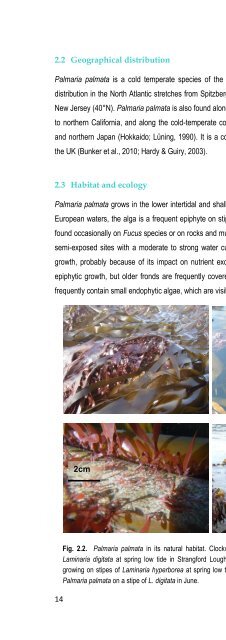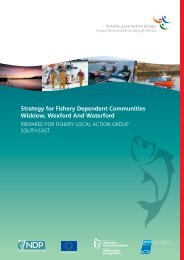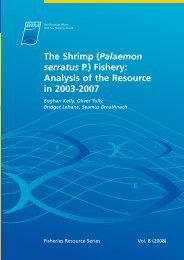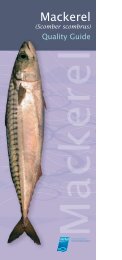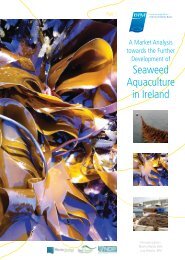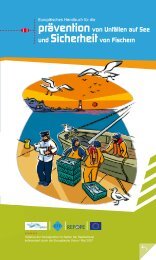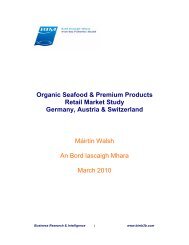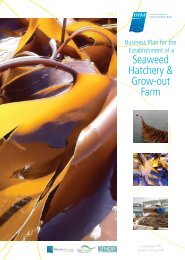Cultivating Palmaria palmata - Bord Iascaigh Mhara
Cultivating Palmaria palmata - Bord Iascaigh Mhara
Cultivating Palmaria palmata - Bord Iascaigh Mhara
Create successful ePaper yourself
Turn your PDF publications into a flip-book with our unique Google optimized e-Paper software.
2.2 Geographical distribution<br />
<strong>Palmaria</strong> <strong>palmata</strong> is a cold temperate species of the North Atlantic and North Pacific Oceans. The area of<br />
distribution in the North Atlantic stretches from Spitzbergen and Greenland in the Arctic (80°N) to Portugal and<br />
New Jersey (40°N). <strong>Palmaria</strong> <strong>palmata</strong> is also found along the Pacific coasts of Canada and the USA from Alaska<br />
to northern California, and along the cold-temperate coasts of eastern Russia (Sakhalin and the Kuril Islands)<br />
and northern Japan (Hokkaido; Lüning, 1990). It is a common constituent of many rocky shores in Ireland and<br />
the UK (Bunker et al., 2010; Hardy & Guiry, 2003).<br />
2.3 Habitat and ecology<br />
<strong>Palmaria</strong> <strong>palmata</strong> grows in the lower intertidal and shallow subtidal zone to a maximum depth of 20 metres. In<br />
European waters, the alga is a frequent epiphyte on stipes of Laminaria hyperborea or L. digitata, but it is also<br />
found occasionally on Fucus species or on rocks and mussel shells (see Fig. 2.2). <strong>Palmaria</strong> prefers sheltered to<br />
semi-exposed sites with a moderate to strong water current. A good water flow has a very positive effect on<br />
growth, probably because of its impact on nutrient exchange. Young fronds of <strong>Palmaria</strong> are normally free of<br />
epiphytic growth, but older fronds are frequently covered by bryozoans and other organisms. Older thalli also<br />
frequently contain small endophytic algae, which are visible as dark brown dots in the tissue, and marine fungi.<br />
14<br />
2cm<br />
Fig. 2.2. <strong>Palmaria</strong> <strong>palmata</strong> in its natural habitat. Clockwise from top left: <strong>Palmaria</strong> growing on the stipes of<br />
Laminaria digitata at spring low tide in Strangford Lough; <strong>Palmaria</strong> at spring low tide submerged; P. <strong>palmata</strong><br />
growing on stipes of Laminaria hyperborea at spring low tide at Ballyrisode Beach, South West Cork; recruits of<br />
<strong>Palmaria</strong> <strong>palmata</strong> on a stipe of L. digitata in June.


